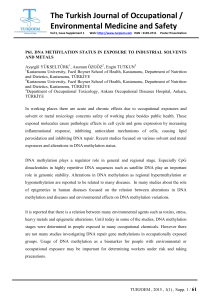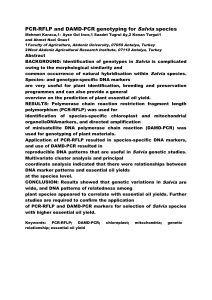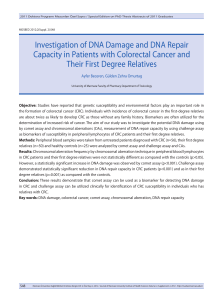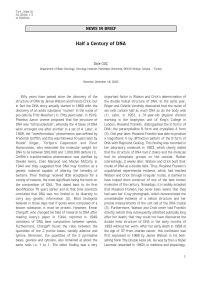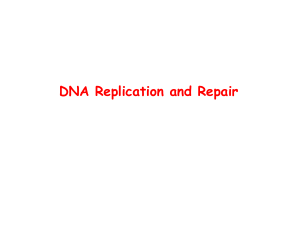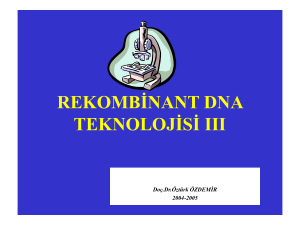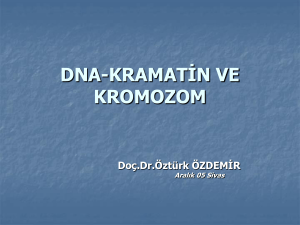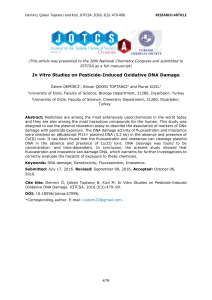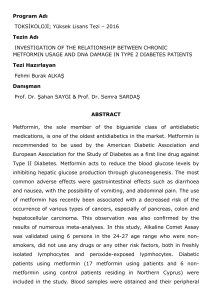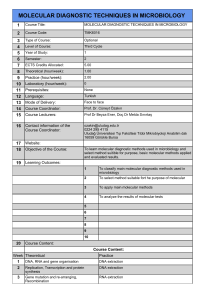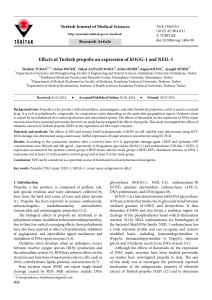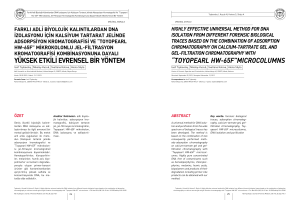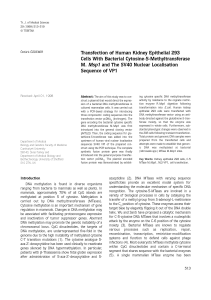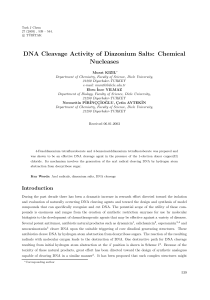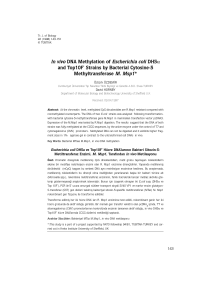PRINCIPLES OF RECOMBINANT DNA TECHNOLOGY
advertisement
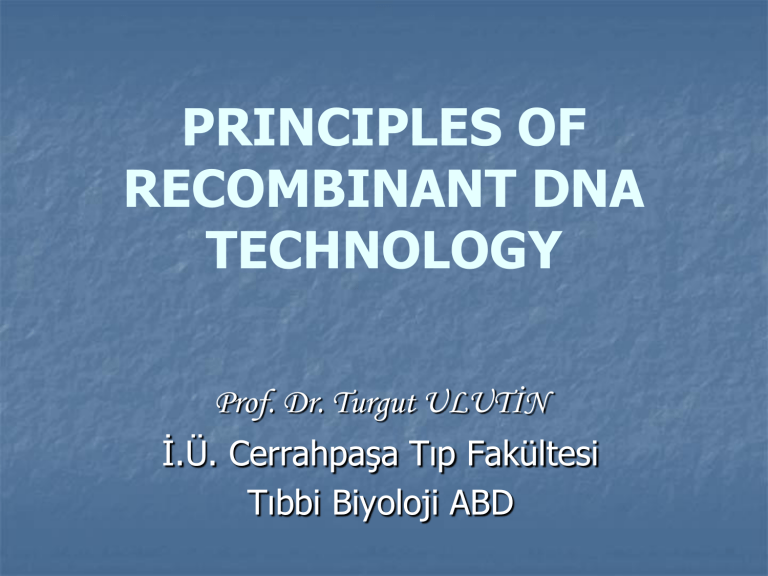
PRINCIPLES OF RECOMBINANT DNA TECHNOLOGY Prof. Dr. Turgut ULUTİN İ.Ü. Cerrahpaşa Tıp Fakültesi Tıbbi Biyoloji ABD Rekombinant-DNA teknolojisinin gelişimindeki önemli atlama taşları: 1860-1865 Gregor Mendel Bezelye çaprazlamaları ile döllere “gen” geçişini ilk kez ortaya çıkardı 1953 Watson ve Crick : DNA' nın çift iplikli sarmal yapısı keşfedildi. 1957 Kornberg : DNA polimeraz izole edildi. 1966 Nırenberg ve ark: Genetik kod çözümlendi. 1967 Gellert : DNA ligaz izole edildi. 1970 Hamilton Smith Restriksiyon enzimlerini (DNA makasları) keşfetti DNA yı belli noktalardan kesebilen enzimler 1972-73 Jackson ve ark : İlk r-DNA molekülü oluşturuldu. Boyer ve ark : Gen klonlama tekniğinde plazmidler keşfedildi 1975 Southern : hibridizasyon tekniği geliştirildi. " Southern Blot " tekniği. Kan ve ark : ilk prenatal teşhis 1977 Walter Gilbert ve Allan Maxam , ayrıca Fred Sanger ayrı ayrı laboratuvarlarda DNA nın şifresini çözecek DNA baz dizisini ortaya çıkaran “DNA dizileme” metodunu geliştirdiler 1978 Yuet Wai Kan ve Andree-Marie Dozy “restriction-fragment-length polymorphism” (RFLP) yöntemini geliştirdiler 1979 Goeddel ve ark: ilk rekombinant – insülin 1982 Palmiter ve Brinster : Transgenik fareler Spradling ve Rubin : Transgenik meyve sinekleri üretildi. 1985-1990 Kary Mullis arkadaşları polimeraz zincir reaksiyonu (PCR) adı verilen , hızlı DNA klonlaması ve dizi tepitinde önemli bir teknik geliştirdiler 1986; İlk hastalık geni pozisyonel klonlama ile tayin edildi ;immun bir hastalık olan kronik granulomatos hastalığı. 1987; Rekombinant hepatit B aşısı üretildi. 1989; ABD de İnsan Genomu Araştırma Ulusal Merkezi kuruldu 1994; İlk transgenik domates satış izni aldı 1993 Stilman ve Hall : İnsan embriyosunun klonlanması çalışmaları . 1997 Wilmut : Koyun klonlanması (Erişkin memeli hücrelerinden) 1998 İnsan Genom Projesi (İGP) başlatıldı 2000 li yıllar: İGP tamamlandı (2003) DNA çipleri Farmakogenetikte atılımlar Kök Hücre - tedavi Rekombinant DNA teknolojisinde kullanılan yöntemler Özel kesici enzimler kullanarak DNA molekülünün kesilmesi DNA nın Klonlanması DNA - nukleotid dizisinin hızlı bir şekilde saptanması Nukleik asit hibridizasyonu Genetik Mühendisliği It is useful consider the essential five steps in the technology: Restriction enzyme cutting which is the generation of DNA fragments in such a way that a particular gene or DNA segment will be included. 2. Recombinant or the incorporation of these fragments into a suitable carrier or vector. Transformation of a host organism, e.g. the bacterium E. coli , by the recombinant vector. Cloning which involves growing the transformed host organism in culture medium so producing multiple copies of the foreign DNA fragments incorporated in the recombinant vector. Finally the selection of clones containing the relevant DNA fragment. Generation of DNA fragments: restriction enzymes The most important development in recombinant DNA when it was recognised that certain enzymes in particular microbes, cleaved DNA at sequence specific sites. These enzymes are called restriction endonucleases and each restriction endonuclease is designated according to the organism from which it was derived. Because of the complementary pairing of bases in the DNA molecule, the restriction endonucleases always create double-stranded breaks. Depending on the particular base sequence which is cleaved either a staggered end results, when DNA has been cleaved by a restriction enzyme which produces staggered termini with complementary nucleotide sequences, these termini are referred to as being “sticky” since they will unite with complementary sequences produced by the same enzyme on DNA if a suitable vector. The cohesive termini are held together by hydrogen bonding but are then sealed and stabilised with an enzyme called DNA ligase. The union of the foreign DNA fragment with that of the vector produces what is variously referred to as a hybrid, or recombinant molecule. Rekombinant DNA teknolojisinde kullanılan yöntemler - 1 Özel kesici enzimler kullanarak DNA molekülünün kesilmesi HpA I 5' G-T-T * A-A-C 3' 3' C-A-A * T-T-G 5' Eco RI 5' G *A-A-T-T-C 3' 3' C-T-T-A-A * G 5' Hind III 5' A *A-G-C-C-T 3' 3' T-T-C-G-G * A 5' Pst I 5' C-T-G-C-A * G 3' 3' G * A-C -G-T-C 5' makasları) Restriksiyon enzimleri (DNA Restriksiyon enzimleri Enzim Elde edildiği kaynak Tanıma bölgesi BamHI Bacillus amyloliquefaciens H GGATCC EcoRI Escherichia coli RY13 GAATTC HaeIII Haemophilus aegyptius GGCC HindIII Haemophilus influenzae Rd AAGCTT HpaI Haemophilus parainfluenzae GTTAAC HpaII Haemophilus parainfluenzae CCGG MboI Moraxella bovis GATC NotI Nocardia otitidis-caviarum GCGGCCGC SfiI Streptomyces fimbriatus GGCCNNNNNGGCC TaqI Thermus aquaticus TCGA Restriksiyon enzimi (DNA makası) olan EcoRI çembersel DNA molekülünü keserek yapışkan uçlara sahip doğrusal şekle getirir Different sources of DNA fragments can be used to make these recombinant molecules. DNA from nucleated cells is termed total or genomic DNA made by the action of the enzyme reverse transcriptase on mRNA is called complementary or cDNA for short. Vectors A vector is the term used for the carrier of the foreign DNA fragment used in the cloning process. Essentially there are three types of vectors used in this work: plasmids, phages and cosmids. All replicate within the host bacterial cell and are therefore sometimes referred to as replicons. Plasmids occur naturally in bacteria to which they confer resistance to various antibiotics, heavy metals, etc. They are stably inherited in an extrachromosomal state, and consist of a circular duplex of DNA. Bacteriophages are viruses which infect bacteria and the DNA is usually in the form of a linear duplex. The may also be used to introduce foreign DNA into the host cell. The most extensively studied and utilized is the so-called lambda () phage. Finally, a cosmid may be used as a vector. A cosmid is essentially a plasmid which has had all but the minimum of the vector DNA removed necessary for propagation to allow or the largest possible foreign DNA fragment. Transformation of host organism After the foreign DNA has been incorporated into the plasmid the plasmid is introduced into the host bacterial cell by exposing the latter to calcium salts which make the cell membrane permeable to the plasmid. This is referred to as transformation. The next step is to grow the host-vector in culture medium to produce clones . If the restriction enzyme used to insert the DNA fragment cuts within the drug resistance gene of the vector then this can be used as a screening procedure. Thus in pBR322 if the enzyme Pst I were used to generate DNA fragments and to open up the plasmid, then any recombinant plasmids produced would make the bacterial host cell it transforms sensitive ampicilin but remain resistant to tetracycline. This would allow one to differentiate the recombinant clones from those without inserts in which the vector has merely been relegated to itself since any host cells transformed by the latter will still be resistant to both antibiotics. Rekombinant dna teknolojisinde kullanılan yöntemler - 4 DNA Klonlaması Vektör kullanarak canlı hücrede DNA çoğaltımı ; *Plazmid *Virus genetik materyeli Polimeraz Zincir Reaksiyonu (PCR) ile çoğaltım işlemi (tüpte) genetik haritası. İki tane antibiyotik dirençlilik geni taşır Plasmid PBR322 nin Kimerik DNA (veya Rekombinant- DNA) oluşturma: Plazmid DNA sının yabancı DNA molekülü ile birleştirilmesi Selection of clones with specific DNA sequences A number of ingenious techniques have been developed for detecting the insertion of specific DNA sequences. For example, if the inserted sequence alters the antigenic properties of the host cell then the recombinant can be screened for using immunochemical methods. However, the most widely used method for identifying clones with specific DNA fragments is by nucleic acid hybridisation . From the plated colonies of bacteria, a replica is plated on to a nitrocellulose filter to which nucleic acids. The replica colonies are then allowed to hybridise with a radioactively labeled gene-specific DNA or RNA probe and monitored by autoradiography, exposure to an X-ray . Once a particular DNA sequence of interest has been cloned, it is possible using other techniques to “sequence” it, i.e. determine the order of the individual nucleotides of that DNA fragment. Restrıctıon Mappıng Another tecnique with wide application from our point of view is that of hybridization with a radioactive probe, using the socalled Southern blot method. Essentially, it consists of subjecting the fragments of DNA, generated by a restriction enzyme, to electrophoresis on an agarose gel which separates the DNA fragments by size. The DNA fragments in the gel are then denaturated with alkali which makes them single-stranded rendering them capable of hybridizing with any complementary DNA sequences. Permanent copy of these single-stranded fragments is made by transferring them on to a nitrocellulose filter. Now, in order to localize and visualize a particular fragment on the filter, a32 P radioactively labeled DNA probe which has been made single stranded is allowed to hybridise with DNA fragments in the “Southern blot” . The probe can be either a cDNA sequence to a specific gene or one produced synthetically, the nucleotide composition being inferred from the amino acid sequence of a particular protein, so-called oligonucleotide probe. The probe is made radioactive by a process known as “nick translation” in which 32P labeled nucleotides are introduced into the DNA molecule. Wherever the radioactively labeled probe hybridizes on the nitrocellulose filter this can be localized by autoradiography. Rekombinant DNA teknolojisinde kullanılan yöntemler - 2 DNA - nukleotid dizisinin hızlı bir şekilde saptanması Enzimatik Yöntem (Sanger Yöntemi) Kimyasal yöntem (Maxam-Gilbert Yöntemi) DNA dizileme yöntemi dideoksinukleotid, 2 , 3 dideoksi CTP. DNA dizileme yöntemi Rekombinant DNA teknolojisinde kullanılan yöntemler- 3 Nukleik asit hibridizasyonu: Southern transferi : DNA hibridizasyonu Nouthern transferi : RNA hibridizasyonu Polimeraz Zincir Reaksiyonu (PZR veya PCR) Kalıp DNA DNA polimeraz (Yüksek ısıya dayanıklı) Primerler dNTP ler ( CTP-ATP-GTP-TTP) Rekombinant DNA teknolojisinde kullanılan yöntemler - 5 Genetik Mühendisliği Transgenik hayvan ve bitkiler üretmek Transgen: Yabancı gen (veya DNA) Transgenik: Yabancı geni taşıyan organizma Transgenik model oluşturmak: Hücrelere yeni gen nakli ( bir gen üzerinde değişiklik yaptıktan sonra -mutant gennormal genin yerine sokulması) ile farklı özellikler taşıyan organizmaların üretilmesi. Transgenik hayvan oluşturma yöntemleri; 1- Döllenmiş yumurtaya gen transferi ile transgenik hayvan (fare) üretimi 2- Embriyonik kök hücrelerine (EKH) gen transferi ile transgenik hayvan (fare) üretimi Transgenik fare: Döllenmiş yumurta hücresine büyüme hormonu geni eklenen transgenik fare dev boyutlarda. Rec- DNA Teknolojisinin Kullanıldığı Alanlar Table 3.2 Applications of recombinant DNA technology 123- 4567- Gene structure/mapping/function e.g.globin gene Population genetics Relation to disease and population structure Control of genetic disease prenatal diagnosis preclinical diagnosis carrier detection Diagnosis and pathogenesis of disease Biosynthesis e.g. insulin, growth hormone, interferon Treatment of genetic disease Insertion of cloned normal gene Agriculture e.g. nitrogen fixation Table 3.3: Single gene disease in man with their molecular basis Disorder Defect Genetics Nature of molecular Dwafism due to growth hormone deficiency (rare familial form, associated with anti- GH antibodies) AR Deletion of GH gene Osteogenesis imperfecta (type lethal in newborn period) AR Partial deletion in collogen genes* Alpha-1-antitrypsin deficiency AR Point mutation Congenital adrenal hyperplasia due to 21- Hydroxylase deficiency AR Deletion* Antithrombin III deficiency AD Deletion* Haemophilia A (bleeding due to Factor VIII deficiency) XR Point mutations and deletion Haemophilia B (bleeding due to Factor IX deficiency) XR Point mutation and deletion Lesch-Nyhan syndrome (HGPRT deficiency) XR Deletion* Duchenne muscular dystrophy XR Deletion* * indicates deletions have been detected in only a proportion of patients. Table 3.4 : Proteins produced by biosynthesis using recombinant DNA Technology Protein Disease ---------------------------------------------------------------------------- İnsulin Growth hormone Factor VIII FactorIX İnterferon Alpha-1-antitrypsin Somatostatin Vaccines İnsulin-depedent diabetes mellitus Dwarfism due to growth hormone deficiency Haemophilia A Haemophilia B Infections, cancer (?) Emphysema due to alpha-1-antitrypsin deficiency (?) Excess growth Hepatitis B, malaria and orher tropical disease (?) Rekombinant DNA teknolojisinin biyomedikal önemi Birçok hastalığın moleküler temelini anlamak (ailesel hiperkolesterolemi, orak hücre anemisi, talessemi, kistik fibroz, müsküler distrofi) Rec-DNA teknolojisi kullanılarak tedavi etmek (örn: insülin, büyüme hormonu, plazminojen aktivatörü) Aşılar üretmek (hepatit B) Tanı (AIDS testi) Tedavi (gen tedavisi) Prenatal tanıda Beta thalessemia, Duchenne müsküler distrofi, Frajil-X sendromu Kanser teşhisinde retroviruslar Onkogenler Mutant genler Aşı üretiminde Yenebilir aşıların üretimi Muz patates gibi ürünlere hepatit B, Kolera aşılarının klonlanması “Çocuklar ölmesin Şekerde yiyebilsinler” Biyoteknolojik çalışmalarda Çevre mühendisliğinde biyolojik savaş süper bakteriler oktan, ksilen, naftalin ve karışık hidrokarbonlar gibi petrol artıklarını kullanabilen bakteri türlerinden , tüm bu özellikleri bir arada taşıyan mikroorganizma. Hastalıkların moleküler seviyedeki patolojik tanıları Diyabet ateroskleroz ve koroner arter hastalıkları Alzheimer , şizofreni, parkinson DNA çipleri Biyoteknolojik çalışmalarda İlaç sanayisinde; “Antitripsin Kistik fibrozda” Adli Tıpta şüpheli suçlunun tayini veya babalık tayini SUMMARY 1- Recombinant DNA technology involves the generation of DNA fragments using sequence specific restriction endonucleases, the incorporation of these fragments into a suitable vector (plasmid, phage or cosmid), the introduction of the vector into a host organism (usually E. coli), and the subsequent selection of clones containing a specific DNA sequence. 2- A DNA fragment may be made radioactive (by labeling with 32P by the process of nick translation) and can then be used as probe to detect homologous DNA sequences on an electrophoretic gel (Southern blot) 3- The technology has been used for analyzing gene structure, the diagnosis of genetic disease (either directly or by linkage with restriction fragment length polymorphisms), research into the molecular pathology of disease, biosynthesis of medically important peptides (insulin, growth hormone, interferon, etc. ) and perhaps one day gene therapy. 4- Concern about the possible biological hazards and potential abuse of recombinant DNA technology has lead to guidelines being drawn up for physical and biological containment. RFLP (Parça uzunluk polimorfizmi)






